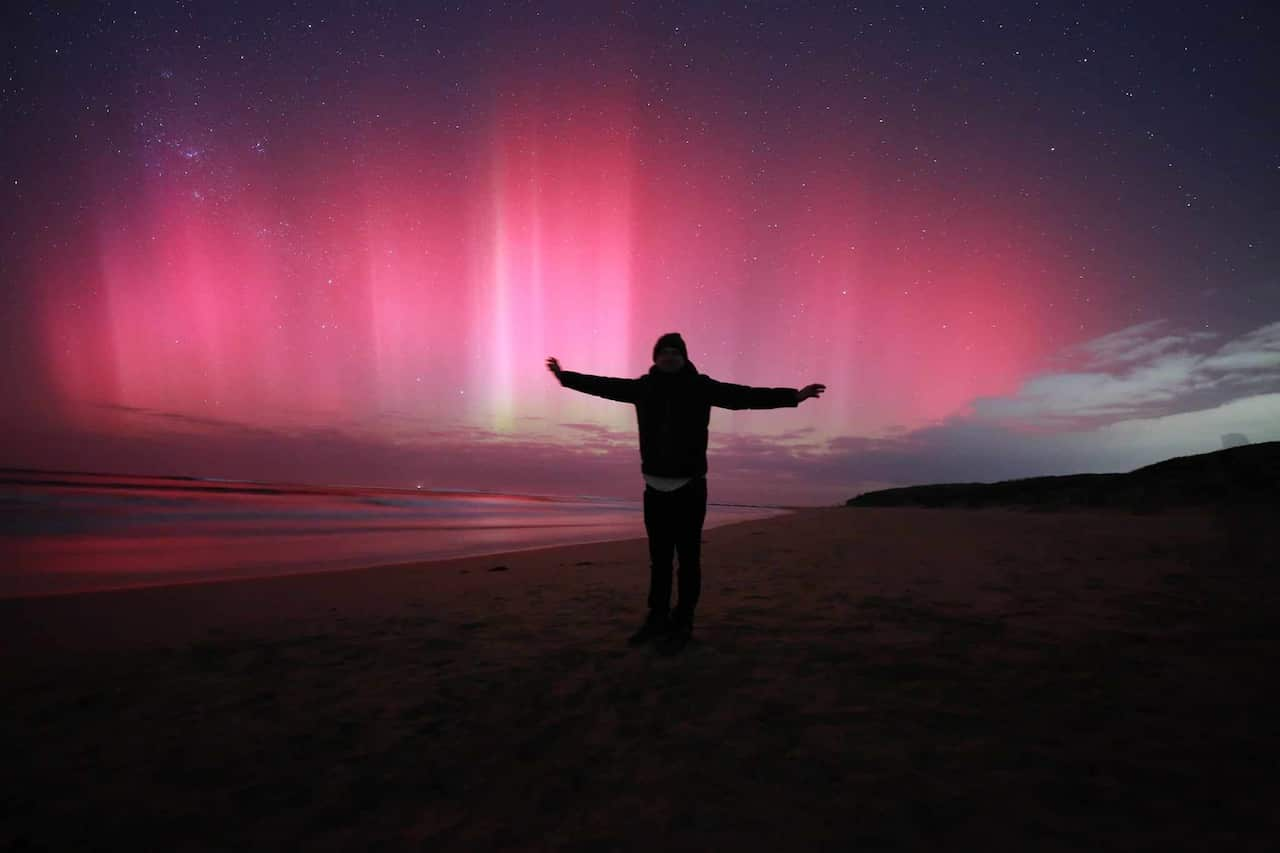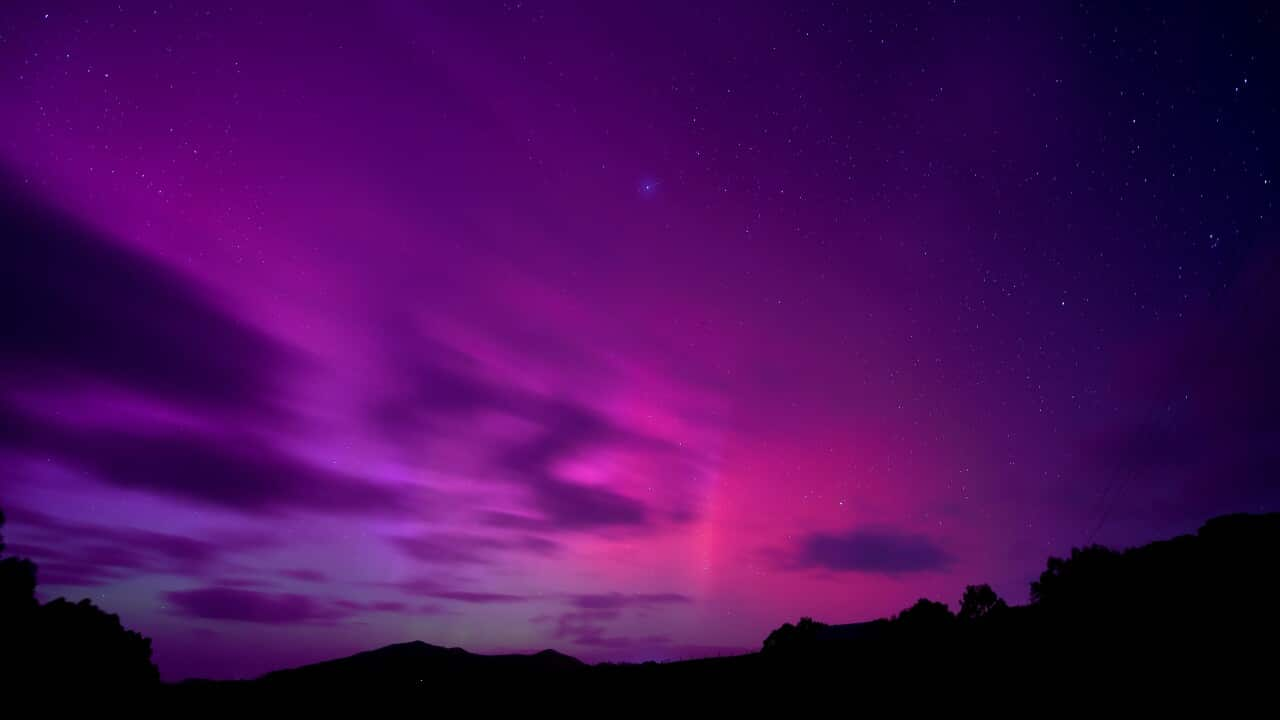Key Points
- Aurora Australis was visible from parts of Australia in the early hours of Friday.
- Ongoing geomagnetic storms mean aurora chasers could see more of the lights overnight.
- Those wanting to try to see the lights should find a south-facing spot without light pollution.
Night sky photos featuring pinks, purples and oranges are being shared across social media in Australia thanks to solar-induced magnetic storms.
Aurora Australis, the solar event which takes place in the Southern Hemisphere, brought colours to nighttime photos captured by aurora chasers in the early hours of Friday.
Theconfirmed aurora sightings were visible in the early hours of Friday across all states and territories except the Northern Territory.
Some, like Melbourne-based aurora chaser Arun Chandran were even able to see some of the colour with the naked eye.
Large expulsions of plasma and magnetic field from the Sun’s corona — or Coronial Mass Ejections (CME) as Chandran and other enthusiasts refer to it — indicate the phenomenon may again grace southern skies overnight on Friday.
Current conditions
The Bureau of Meteorology Australian Space Weather Forecasting Centre is observing a severe (G4) geomagnetic storm event globally with the Australian region currently recording a strong (G3) storm event.
A BOM spokesperson said it was predicting these geomagnetic conditions may continue until Saturday.
“If current conditions persist, aurora will be visible during local night hours tonight, with the evening hours likely to be most favourable,” they said.
“Should forecast conditions eventuate, aurora sightings may be possible as far north as dark-sky locations in Perth and Sydney, but likely less intense than what was observed early this morning.”
Aurora chasing
Chandran, who works in IT, became interested in auroras a few years ago and started a Facebook group about Aurora Australis, ahead of the light show that dazzled skies in May.
“I have another Facebook page called Explore Melbourne and there were a lot of people wanting to find out where to go to see it and there was a lot of knowledge people wanted,” he said.
Chandran shared information from BOM and the National Oceanic and Atmospheric Administration on the page and answered questions about auroras.
Now his group has 50,000 members and he has published a book about Aurora Australis.
Arun Chandran enjoys the elusiveness of aurora chasing. Source: Supplied / Arun Chandran
Chandran said it is the elusiveness of auroras that is almost spellbinding and captures people’s interest.
“It’s the elusiveness, the thrill of the chase, the more you chase auroras, the more you understand the numbers — there’s so much uncertainty. Luck matters, even the forecasts the authorities put out, it’s just tentative,” he said.
Chandran said he enjoys the social element of being part of group watching for an aurora, so enjoys himself even when there ends up being little to see.
And while the most impressive colours in the sky are only seen through a camera, Chandran said on Friday morning “the colours were pretty strong” and he and the group he was with on a Geelong beach were able to see some colour with the naked eye.
What is an aurora?
Auroras are caused by ‘solar wind’, a stream of electrically charged particles that travel from the Sun towards Earth at speeds of up to 2000km per second.
Most of these particles are intercepted by the Earth’s protective magnetic field, but some travel down the magnetic field lines at the north and south poles.
When these particles interact with gases in the atmosphere, they create a technicolour display of lights in the night sky.
According to the United States’ National Aeronautics and Space Administration (NASA), atmospheric reactions with oxygen give off the aurora’s characteristic green and red lights, while nitrogen is responsible for its blue and purple glow.
The solar event is called Aurora Australis in the southern hemisphere and Aurora Borealis in the northern hemisphere.
Tips for aurora chasing
Chandran said not only do aurora chasers need to position themselves somewhere that is south-facing, it is important to go somewhere with little light pollution.
“I’m not talking about not having street lights, I’m talking about away, probably three kilometres away from the closest light,” he said.
Chandran often helps people take photos and suggested people check what settings their phones or cameras might need to be on to take the best photos and also use a a weather app to check for cloud coverage, as clear skies are needed.
Given aurora chasing can involve hours of waiting, he suggested people find a location with toilets nearby and to make sure they take their rubbish home with them.
“In May when a lot of people were on the beaches for the Aurora Australia, a lot of people left a lot of rubbish,” he said.
Chandran also urged people to take extra care moving around, as people would likely visit places they had not visited before and in the dark, hazards can become greater, especially when large numbers of people converged in the same area.

